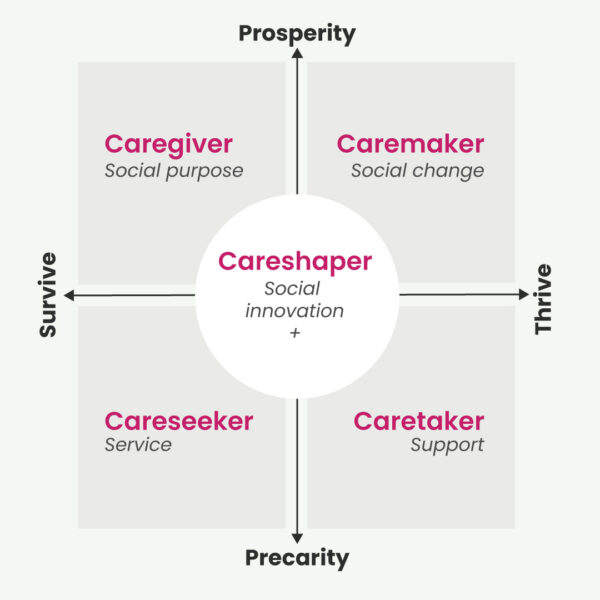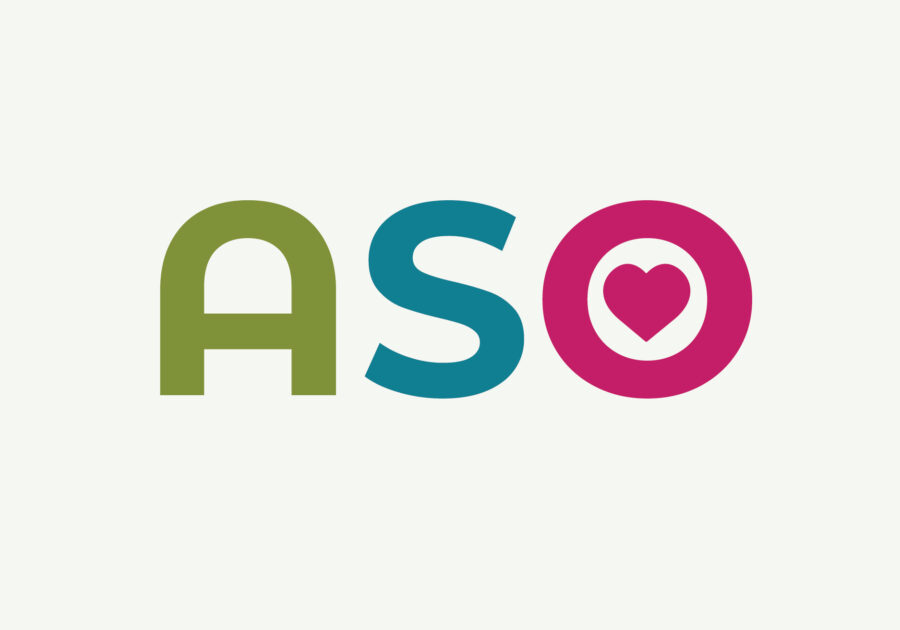Found it! is an occasional blog series by ArtsPond Founder, Jessa Agilo. In this article, Jessa ruminates and shares a game about the future of service, support, innovation, and care in Canadian arts and culture, including creatives and Arts Service Organizations (ASOs).
ASOs are an essential part of Canada’s arts and culture ecosystem and have been so for decades.
And yet, in an age of perpetual polycrisis, what might, could, or should that “S” in ASO reflect or represent in the near to distant future? Service? Support? Something else or, somehow, more?
Here at the pond, we have walked the edges of a ‘somewhere there’ that is at times scary, strange, and surprising, but always deeply satisfying. Last week, I was delighted to speak with learners at Humber about my love for ASOs as well as my hopes and fears for a future rooted in arts and culture-led polycare with people, communities, and the planet. By all measures, I am confident the challenges of this journey will be well cared for in the hands of the next generation. You got this, good people!
In the present day, how might we each come together to explore our uncertainties and dreams for the future with greater focus, urgency, and intent? Could playing a game help?
In the early 1960’s, Dutch sociologist and Holocaust survivor Frederik Lodewijk Polak created a classic text in the field of futures and foresight studies called, The Image of the Future. In the early 2000s, Peter Hayward drew upon key insights from this text to develop the popular Polak Game, also known as Where do you stand?
In this game, participants explore their personal views of the future using a 2 x 2 matrix measuring Optimism and Pessimism on the first axis, and feelings of “I can or can’t make a difference” on the second. To imagine where they stand, participants in the game answer two questions:
- Do you see the world as getting better or worse?
- How capable do you feel of personally affecting the future?
Depending on their answers, participants in the Polak Game fall into one of four categories, including: Powerless, Realistic, Passive, or Powerful.
I have found this game to be an engaging and accessible tool as our team has tried to imagine what a more care-centered approach to service and support might look like within arts and culture in the future.
As a thought experiment, I have sketched out the beginnings of an adaptation to the Polak Game. It is suited to creatives and support workers in arts and culture who are seeking to explore what the future of arts services, support, and care looks like to them. However, rather than opposing either/or’s like Powerless-Powerful, this adaptation seeks to root all participants in the power of seeking and giving care, and more. An outline for the game is shared below.
Care Game: How do you care?
Step 1
Consider the following two questions, either individually or in discussion with a small group:
Do you see the world as getting better or worse?
For example, “better” could involve a more prosperous and thriving future filled with abundance and love. “Worse” could involve a more precarious and uncertain future filled with scarcity, loss, and a greater focus on surviving rather than thriving.
What types of care do you believe will personally affect the future?
Consider the different ways you are seeking care or wanting to give care to others in the future. What types of care are critical, common, or nice-to-have? What approaches to care require the status quo to be challenged or changed? What ways of caring demand protections for the common good? In what ways do you expect to struggle to survive? In what ways will you thrive? In the moment, what kinds of care will help strengthen your feelings of security, safety, comfort, and happiness? What types of care will help you become a better caregiver to individuals, communities, and the planet? What is needed to help lift yourself and others into prosperity? What types of care are essential to survive disasters? Deserts? Daily basic needs for survival? Doulas for comfort? Dreams for a thriving, prosperous future? What types of care would you like to see with, by, and for artists? Arts support workers? ASOs? Government? Business? Public? Others?
Step 2
Map out your responses onto the 2 X 2 matrix shown below. To help organize a variety of perspectives, try segmenting your responses within each region as either “seeking” (care you need or desire) or “giving” (care you hope to or you are ready to share).

Step 3
Discuss and share your insights with others in your community.
In the matrix shown above, the vertical axis represents a range of potential futures between Precarity (bottom) and Prosperity (top). The horizontal axis reflects a range of possible future realities from Survive (left) to Thrive (right).
Depending on their answers, participants may fall into any or all of five categories:
Careseeker (Precarity + Survive)
Perspective: People have perceptions of the present that are not positive, and they believe things are getting worse. They believe there is nothing they can do about it and are seeking out care to fill gaps in meeting their daily needs for security and survival. Sample care: Service orientation; such as ASO established or subsidized fee-for-service models providing resources and training that help address the daily survival needs of low-income youth or seniors in arts and culture.
Caretaker (Precarity + Thrive)
Perspective: People have perceptions of the present that are not positive, and they believe things are getting worse. However, they believe there is something they can do to make a difference in the present, and while they may not be able to change the future, they believe it is worthwhile to try. They take care of themselves and others to protect what is needed to survive and strengthen their resolve to bounce back when the time is right. Sample care: Support orientation; such as ASO advocacy, networking, or other volunteer and in-kind support for gig workers faced with loss of work due to the pandemic.
Caregiver (Prosperity + Survive)
Perspective: People have perceptions of the present that are positive, and they believe things are getting better. However, while they believe they can make a difference now and in the future, they believe they must play a part within a larger system that is flawed and resistant to change. They give care to others to help them become more resilient in the face of social barriers that hinder and harm. Sample care: Social purpose orientation; such as an ASO mutual aid network that connects precarious creatives and thriving caregivers together.
Caremaker (Prosperity + Thrive)
Perspective: People have perceptions of the present that are positive, and they believe things can get better. They are eager to make a difference both now and in the future. They are ready to guide and transform barriers in the system so it is more caring and open to change. They make opportunities for care to be more accessible to diverse groups so we may all thrive and contribute to advancing positive social change. Sample care: Social change orientation; such as an ASO that employs disabled people to educate businesses on ways to make their products or services more accessible.
Careshaper (All or Intersectional)
Perspective: People have perceptions that both reflect and transform the beliefs in all the other four categories. They are positive deviants that have the capacity to engineer caring ecologies across systems, communities, and the planet. They are able to thrive and offer deep and impactful care within their communities that reduces the negative impacts of precarity and elevates prosperity for all. Sample care: Social innovation, systems innovation, or other orientation; such as an ASO that incubates new business models in response to the climate crisis.
Who cares? Why it matters.
Overall, I firmly believe each and everyone one of us have the potential to be careseekers, caretakers, caregivers, caremakers, and careshapers at different points or in different realms of our lives. However, I fear the dominant, “change”-focused conversations around social innovation and social change have devalued the essential perspectives and contributions of those seeking and giving care when they are needed more than ever.
As a work-in-progress, one of my goals for this adaptation is to help creatives and support workers from arts and culture better understand their own needs and desires for seeking out and giving care in the near to distant future.
In our community, words like service, support, innovation, change, and care are used a lot and yet it is not always clear what they mean to us. Sometimes they are used interchangeably to imply similar things, while other times they are held onto as hopeful if vague and cloudy terms without a specific wisdom or practice we can call to.
Over time, I hope this game will be able to help add a few layers of potential meanings or understandings to these words as we all seek to root out the systems that entrench precarity, scarcity, and loss, while amplifying those that lift up prosperity, abundance, and love.
For us here at the pond, it is becoming increasingly clear that traditional approaches to providing service and support are no longer sufficient. New models, new words, meanings, and intentions are needed in every facet of our lives if we are to not only survive, but thrive, in the face of this ever-present polycrisis.
We truly believe arts and culture can be a positive lifeforce of polycare in our world. Let’s make it so!
